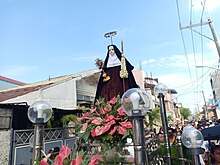Padre Dámaso Verdolagas is a fictional character in the novel Noli Me Tángere. The novel was written by José Rizal, one of the leaders of the Propaganda Movement in the Philippines. Noli Me Tángere is a controversial and anticlerical novel that exposed the abuses committed by the Spanish friars and the Spanish elite in colonial Philippines during the 19th century.
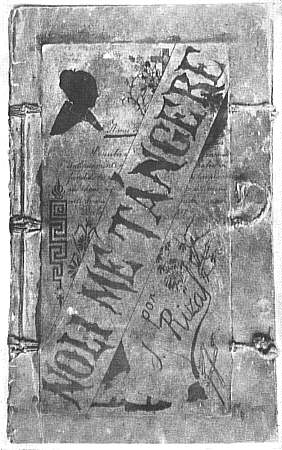
Noli Me Tángere is a novel by Filipino writer and activist José Rizal and was published during the Spanish colonial period of the Philippines. It explores perceived inequities in law and practice in terms of the treatment by the ruling government and the Spanish Catholic friars of the resident peoples in the late-19th century.

Rizal Day is a Philippine national holiday commemorating life and works of José Rizal, a national hero of the Philippines. It is celebrated every December 30, the anniversary of Rizal's 1896 execution at Bagumbayan in Manila.

Obando, officially the Municipality of Obando, is a 2nd class municipality in the province of Bulacan, Philippines. According to the 2020 census, it has a population of 59,978 people.

San Miguel, officially the Municipality of San Miguel, is a 1st class municipality in the province of Bulacan, Philippines. According to the 2020 census, it has a population of 172,073 people.
A triduum is a religious observance that lasts three days.

Our Lady of Salambáo is a Catholic title of the Blessed Virgin Mary venerated in Obando, Bulacan, Philippines. The Virgin Mary under this title is venerated as the local patroness of fishing, owing to the image's discovery in a salambáw, a type of big fishing net supported by bamboo crosspieces and mounted on a raft.

Jerónima de la Asunción, O.S.C. was a Spanish Catholic nun and abbess who founded the Real Monasterio de Santa Clara in Intramuros, Manila, Philippines.

The Diocese of Malolos is a Latin Church ecclesiastical jurisdiction or diocese of the Catholic Church in the Philippines, encompassing the whole Province of Bulacan and Valenzuela City in metropolitan Manila and is a suffragan to the metropolitan Archdiocese of Manila. The mother church of the Diocese is the Cathedral-Basilica of the Immaculate Conception located in Malolos City, Bulacan. The Blessed Virgin Mary, under the title of Immaculate Conception is the principal patroness of the diocese.
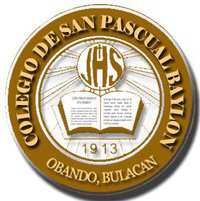
Colegio de San Pascual Baylon or the College of St. Paschal Baylon (CSPB, formerly Escuela Catolica and St. Pascual Institution is a collegiate school at Obando, Bulacan in the Philippines. The school started as a catechetical school on February 11, 1913, through the efforts of Rev. Fr. Juan Dilag, then parish priest of Obando. It became a pre-elementary school, and elementary institution in 1936, added a secondary level in 1939 through 1943, then became a college. Formerly managed by the Sisters Religious of the Virgin Mary, it is currently managed by the Dominican Sisters of St. Joseph, a religious congregation in Bulacan. It was formally recognized by the government of the Philippines in 1921. Its name was derived from one of Obando, Bulacan’s patron saints.
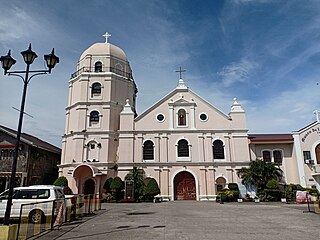
The Parish of San Pascual Baylon and National Shrine of Nuestra Señora Inmaculada Concepcion de Salambao(Filipino: Parokya ni San Pascual Baylon at Pambansang Dambana ng Nuestra Señora Inmaculada Concepcion de Salambao), commonly known as Obando Church, is a Roman Catholic church located in the municipality of Obando in the province of Bulacan, Philippines.
"Sa Aking Mga Kabatà" is a poem about the love of one's native language written in Tagalog. It is widely attributed to the Filipino national hero José Rizal, who supposedly wrote it in 1868 at the age of eight. There is not enough evidence, however, to support authorship by Rizal and several historians now believe it to be a hoax.

José Protasio Rizal Mercado y Alonso Realonda was a Filipino nationalist, writer and polymath active at the end of the Spanish colonial period of the Philippines. He is considered a national hero of the Philippines. An ophthalmologist by profession, Rizal became a writer and a key member of the Filipino Propaganda Movement, which advocated political reforms for the colony under Spain.

María Clara de los Santos is a character in José Rizal's novel Noli Me Tángere (1887). The beautiful María Clara is the childhood sweetheart and fiancée of the protagonist, Crisóstomo Ibarra, who returns to his Filipino hometown of San Diego to marry her. After Ibarra is implicated in a fake revolution and is thought to be dead, María Clara opts to become a nun rather than marry another man. She remains unhappy for the rest of her life and her death is later mentioned in the sequel, El filibusterismo (1891).
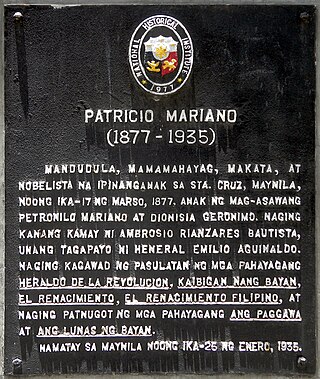
Patricio Mariano y Geronimo was a Filipino nationalist, revolutionary, pundit, poet, playwright, dramatist, short story writer, novelist, journalist, violinist, and painter. Mariano was a Katipunan member. Mariano was the son of Petronilo Mariano and Dionisia Geronimo.

San Juan de Dios Parish Church, also San Rafael Church, is an 18th-century Roman Catholic church situated in Brgy. Poblacion, in San Rafael, Bulacan, Philippines. Its titular patron is St. John of God; Saint Raphael, archangel, is the secondary patron saint. It is in this church that the Battle of San Rafael took place, wherein hundreds of retreating Filipino soldiers and civilians lost their lives during a battle with the Spanish on November 30, 1896. A historical marker by the National Historical Commission of the Philippines was installed in front of the church in 1997 to commemorate the massacre of an estimated 800 Filipinos.
This is the timeline of the Philippine Revolution—the uprising that gave birth to Asia's first republic. The roots of the revolution trace back to the Cavite mutiny and subsequent execution of Gomburza in 1872, and ended with the declaration of independence from Spain in 1898.

Salambáw, is a type of lift net used by indigenous fishermen in the Philippines. They are found throughout the Philippine islands but are most prevalent in large lakes like Laguna de Bay, and sheltered coastal areas like Manila Bay, Ragay Gulf, and Batan Bay. Variations of salambáw lift nets include the bintol, panak, tangkal, and the basnig. Salambáw rafts were also known as saraboa or salakab.
Noli Me Tángere is a 1961 Philippine period drama film co-written and directed by Gerardo de León. Based on the 1887 novel of the same name by José Rizal, it stars Eduardo del Mar, Edita Vital, Johnny Monteiro, Oscar Keesee, Teody Belarmino, and Leopoldo Salcedo. The film was released on June 16, 1961, timed with the centenary of Rizal's birth.

Maria Clara at Ibarra is a Philippine television drama fantasy series broadcast by GMA Network. The series is based on the novels Noli Me Tángere and El Filibusterismo by José Rizal. Directed by Zig Dulay, it stars Barbie Forteza, Julie Anne San Jose and Dennis Trillo. It follows Klay Infantes, a Gen-Z nursing student who gets transported into the setting of Noli Me Tangere and El Filibusterismo.


